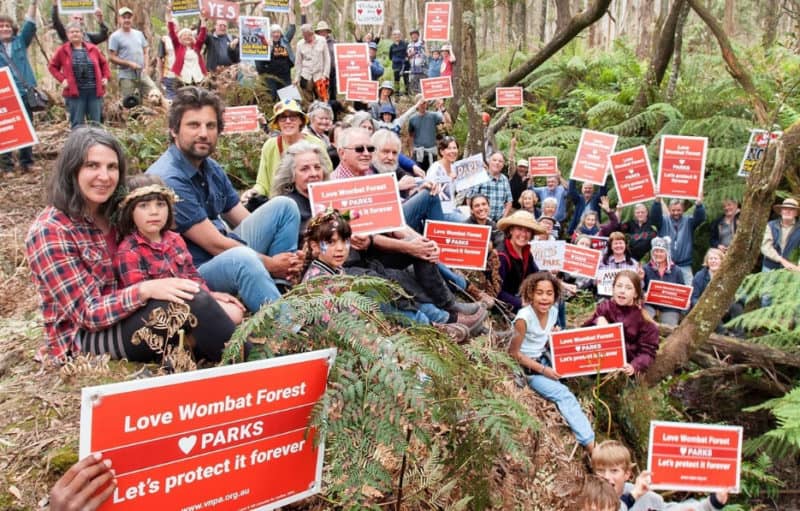PARK WATCH September 2021 |
Jordan Crook was in the eye of the storm – and explains what is necessary in the aftermath.
On the night of the 9th of June, wild winds tore across the state, leaving in their wake downed trees, damaged houses and infrastructure, and vast swathes of forests flattened.
In the Yarra Valley where I live, power was lost for many weeks, and clean-up works are still ongoing.
Heart-breaking scenes the following morning of large old trees that had withstood thousands of storm events smashed across roads and paddocks showed the ferocity of these winds.
The Dandenong Ranges and its grand stands of Mountain Ash and Mountain Grey Gums and its valleys of cool temperate rainforest had been hammered. Towering trees that had taken so long to grow could not withstand the unusual easterly gale-force wind, heavily sodden soil from massive downpours, and in many cases the being weakened from past development and poor tree management.
Similar damage was seen across the state. Friends of Tarra Bulga National Park reported so many large old trees downed that some tracks are still closed. Large patches of the Wombat Forest can be seen from aerial footage to look from above like spilt matchsticks. The impact on species like the Greater Glider that live in these forests is still unknown.
Arborist Dr Greg Moore from Melbourne University has suggested the storm and gale-force winds that hit the state are yet another warning of the future in the changing climate and likely to be more and more common.
As the clean-up continues, there is a need to understand the impact on threatened species and ecosystems. Clean up in a precautious and sensitive manner especially within the parks estate is critical. Just like after fire or flood, ecosystems are recovering from the toppling of so many trees and wildlife left homeless. The mass disturbance across the landscape will also promote further infestation of pest plant and animal species into natural areas.
Arborists use tree risk assessments regularly to calculate the risk of tree failures causing harm using their knowledge of tree health and physiology, the possibility of harm caused by tree failure, and defects within the tree or past damage that could cause failure.
It is obviously very important to clear roads and infrastructure after these events, but dead trees should be retained in the landscape once they have fallen. In particular, logs with hollows play an important role in the local ecology and provide habitat for small ground-based mammals such as Antechinus and Bush Rats, and decaying wood is important for fungi growth as well as being home to a myriad of insects and small reptiles.
We also echo the concerns and wishes of locals that the timber not be taken for commercial purposes but used within the community and conservation estate if it must be removed.
And, of course, the utmost care must be taken when cleaning up around surviving trees.
There is also a great imperative to get in and start managing emerging weed infestations to allow the ecosystem to recover effectively and nip in the bud future weed and pest issues caused by this massive disturbance event. Similar successful programs for controlling deer were put in place after last year’s fire, and similar should be considered in this circumstance.
As Southern Dandenong’s Landcare President Robert Pergl stated in the media, “Recent storm damage on Melbourne’s doorstep at the Dandenong Ranges highlights the need for more funding to manage these unique bushland areas. The recent disturbance from the storms, will lead to a flourish of invasive weed growth, amplifying a pre-existing issue that needs serious government commitment for future conservation management.”
Gayle Osborne of Wombat Forestcare added, “The scale of the damage in the national parks and reserves of the Dandenong and Macedon Ranges is immense … and highlights the need to understand the impact of [the] storm on our parks and wildlife. It is important not to rush in with heavy machinery, except to clear infrastructure, as the best way forward to protect the fragile environment, the areas need to be assessed”.
We couldn’t say it better. We are currently working with local community groups to monitor works within storm impacted areas and advocating for an ecologically sensitive clean up where it is needed. We have also joined with local groups calling for a wildlife and ecosystem recovery package to help manage ongoing threats such as weed and pest control and an ecological assessment of the storm damage to parks and reserves.
As these severe weather events increase due to climate breakdown, we must build resilience into our natural areas, and respond to the aftermath in an ecologically precautious manner.
Did you like reading this article? You can read the latest full edition of Park Watch magazine online here.
Want to be kept up to date about this and other nature issues in Victoria? Subscribe to our email updates.
You can also receive our print magazine Park Watch four times a year by becoming a member. Find out more here.
